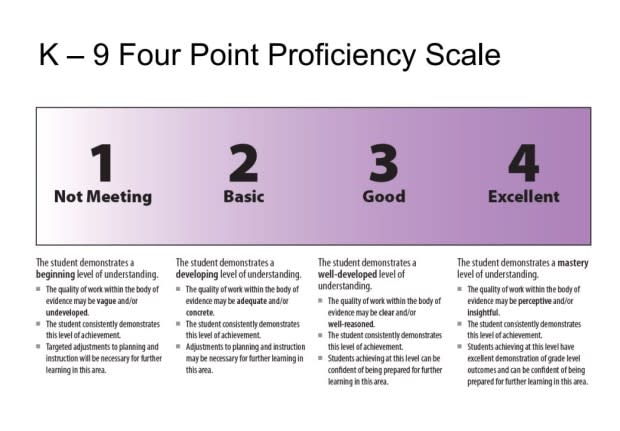CBE changes grading levels for K-9 report cards
The Calgary Board of Education has made some changes to its report cards for students in kindergarten to Grade 9.
While the school board has had a four-point proficiency scale for a number of years for kindergarten to Grade 9, the descriptors for those have now changed.
"That's to provide clarity around the degree or level of achievement," said the superintendent of school Improvement, Joanne Pitman.
She said if a student were to achieve a "1" connected to a category of learning in a subject, that would mean they are not meeting the grade level outcomes.
"What we've added to each descriptor identifies first of all that this is a consistent demonstration of that level of achievement and of that degree of achievement," Pitman said.
"And then it also identifies specifically what teachers will do. So, if a student is achieving a 1 — as not meeting and is at a beginning level of understanding of that particular category of outcomes — it indicates that targeted adjustments to planning and instruction will be necessary for further learning."
Further expanding on that example, Pitman said that "1" now also provides parents with an indicator that they can expect, and should be able to engage further with their child and their teacher around what are the next steps toward moving to the next level.

"It's not simply about a subject. There are larger categories of outcomes that are organized through report card stems," she said.
At the top of the scale is "4," or "excellent." Pitman said previously the descriptors for that grade were "subtle and thorough."
"We wanted to provide a fair bit more clarity and direction around the description [to say] that the student demonstrates a mastery level of understanding. And so in that particular area mastery means the full demonstration of what is described in the outcomes in the program of study," she said.
Still work to be done
Trustee Lisa Davis said that while these changes are a step in the right direction, the board continues to hear lots of feedback from parents who say the 1-to-4 system doesn't provide them with enough information.
"There's no question that there is still work that needs to be done to provide greater clarity to our teachers across the system to ensure that a 2 in one school equals 2 in another school," she said.
"Work also needs to be done to ensure that it's clear to students and parents as to what these achievement levels mean but also more that just the report card is that students understand clearly, regardless of their age, what is required to move from a 2 to a 3, for example."
Davis said administration has made it clear that these changes are the beginning of this work.
"And so what I'm very hopeful of is that over the next year there will be additional change, that changes that come will help ensure that these are clear for students and parents," she said.
Why not percentages?
When it comes to questions about using percentages on report cards (more specifically at the middle school or junior high levels), Pitman said people tend to wonder about them because it's what they've personally experienced.
"For many of our parents, that's what they've experienced in school and how they've calibrated and 'known what it is they've learned,' has been through percentages," she said.
But Pitman said simply applying a percentage does not describe achievement of the outcome.
"Providing a 72 per cent or an 85 per cent may compare you to somebody else, but our goal is not to compare to other students but, in fact, for every student to ensure they are achieving the full outcomes listed in curriculum."
Along with these report card changes, administration has also made partial changes to the K-9 report cards in the area of math.
Changes to math stems
On previous CBE report cards, the stems (categories that organize assessment information for communication to students and families) were for "conceptual understanding; problem solving; mental math and estimation; computation strategies; and models, represents, communicates."
But what they've done now is created new stems that "more clearly" support actual strands reflected in the curriculum, while also acknowledging that the previous stems are part of the way they achieve those strands.

The new stems do vary slightly by grade and curriculum, but generally speaking are now related to "number; patterns and relations; shape and space; and statistics and probability."
"I do think that the math changes, in particular, are a lot more clear because they talk specifically about areas of competency that students are expected to have — and I think that is more clear for parents to understand," said Davis.
"My comment to parents and students is to give your feedback to your teacher and principals as to whether these changes are meeting your needs to help inform you as to where your child is at when his report cards come out."

